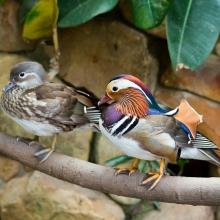Aix galericulata

Conservation Status:
Least Concern
Range:
Eastern Asia
Habitat:
Woodlands in mountains, and forests with marshes and streams
Mandarin Ducks exhibit sexual dimorphism (literally "two forms"). The males display vibrant colors, with a purple chest, orange head, and orange feet. These bright colors aid in attracting females and asserting territorial claims. The females, on the other hand, primarily exhibit a mottled brown plumage with brown feet, enabling them to blend into their surroundings. Both genders have webbed feet and claws. With their sturdy wings, they navigate through flight with ease, unlike most other ducks that flap their wings repeatedly. They are known to perch high in trees.
They also nest in tree cavities. The selection of the nest site is primarily the female's decision, although the male participates in the search. The female lines the nest with down feathers before laying 9 to 12 eggs. Shortly after hatching, the mother calls to the chicks from the ground, prompting them to free fall from the tree, after which they all venture off in search of food. Fledging occurs after 40 to 45 days.
The diet of Mandarin Ducks varies depending on the season. During the summer, they consume frogs, mollusks, small snakes, fish, and worms. In the winter, their diet consists of grains, beechnuts, seeds, and plants.
